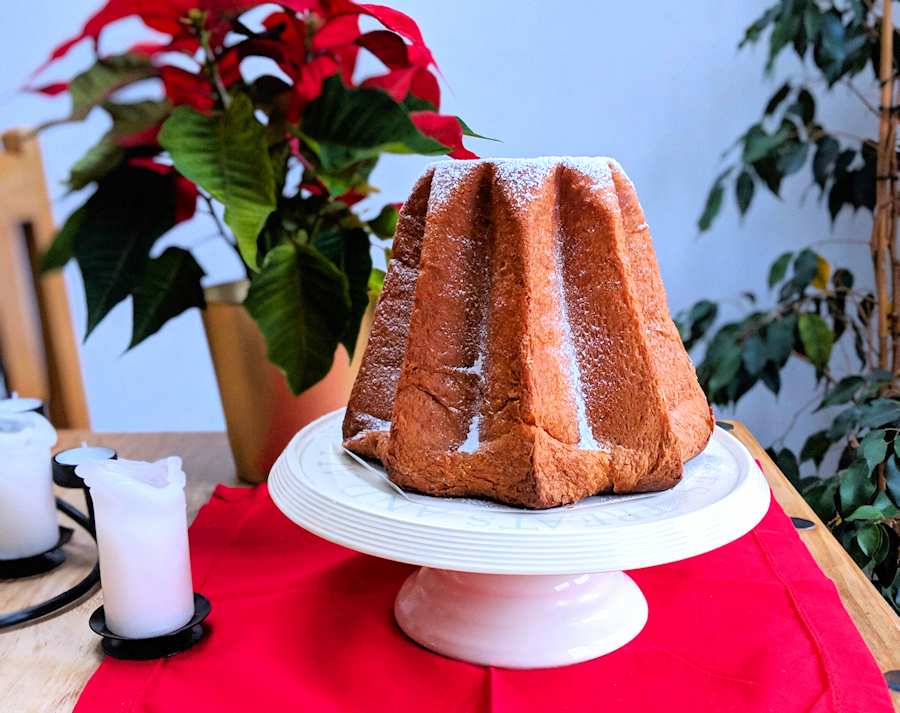Pandoro, the golden bread, is panettone’s Christmas rival. It comes from Verona and it’s divinely fluffy; and so richly delicious you won’t even notice there’s no candied fruit.

Where’s our native Christmas bread?
There is no English Christmas bread! Honestly, it makes me really embarrassed that we only have the sickly sweet Christmas cake or even more sickly concoction of brandy and prunes that gets steamed, of all the cooking methods, and called Christmas pudding.
I know, there are mince pies and very fine Christmas sweets they are too, but how come we have nothing tasty that you can toast and butter on Christmas morning?
Everyone else has a julekake or a Stollen, a babka or a pulla, or at least marzipan or cinnamon rolls. And it’s definitely not right that Italians should have two to choose from!
Panettone vs. pandoro
Panettone and pandoro are the two famous ‘breads’ (really cakes but yeast-leavened so often called breads) fighting for primacy in Italian families, dividing the raisin-chasers and the candied peel-haters.
‘Boring!’ say the former. How can you have such a vast expanse of cake without anything interesting in it? Make bread and butter pudding of it already and make sure you throw in sultanas!
Ah, but orange peel is vile, say the latter. Non mi piace! Wrong flavour! And all those raisins, totally unnecessary. Give me a plain honest slice of cake, but so fluffy, rich and buttery that I won’t need any embellishments!
I’m baking pandoro this year, and got myself the genuine star-shaped tin for it. The recipe is a somewhat simplified version of the Italian one off the tin suppliers' website, Vespa Dolci Forme. It tastes so good! Plus, although by no means easy, it’s nowhere near as challenging to make as genuine panettone.
How long does it take?
Less stressful as well as less and time-consuming than panettone, it still requires a couple of hours of an evening and the following morning of your time.
Biga, sponge and main dough
The dough is made in three stages. First, it’s the biga to let the yeast wake up and get energetic, mixed in warm water with a little flour, a spoonful of sugar and one egg yolk. That mixture needs to sit in a warm spot for about an hour, to double in volume.
The next stage is the sponge, which means boosting the biga with a pinch more yeast, plus more food for it: more flour, sugar, egg and some softened butter. While the biga can be mixed with a spoon, the sponge will benefit from standing mixer action, fitted with a paddle attachment not dough hook because at this stage the dough is still very liquid. Once well beaten, the sponge needs to rest in a warm place to expand.
The main dough means adding more flour, eggs, some sugar and aromatics. Note here: it is very important to use extremely good quality vanilla extract, if vanilla pods are out of your price range, and I know how exorbitant real vanilla is. If you can splash though, do: it makes a huge difference in the flavour of baked pandoro.
Perfectly mixed dough, to the windowpane test if possible, goes into the fridge overnight, to prove and ferment.
The final stage and baking
In the morning the cold dough will get the final enrichment of soft butter. Shape it into a smooth ball next, and drop into the fancy star-shaped, buttered pandoro tin (or an ordinary bundt tin). The final rise will take at least two hours and up to four, because we’re starting with cold dough. It should come up to the rim of the star tin and in a generic one – triple in volume.
Baking takes about forty minutes in all, with the oven turned down slightly midway. Out of the oven, after it cools down a little, you can turn it out onto a cooling rack and shower it with icing sugar, preferably vanilla-flavoured, when cold.
If during baking the top of the cake has bulged a little, you can trim it to make pandoro sit flat on a plate. And of course that trimming is the well-deserved baker’s prestige!
It should be sliced horizontally so that everyone gets a star-shaped slice, with whipped cream or sweetened mascarpone on the side.
Pandoro keeps well, perhaps not quite as well as panettone but it will be still nice after a few days. And then even nicer toasted.
More Christmas baking recipes
Pompe à huile, sweet olive oil brioche traditionally served in Provence, South-East France, at Christmas. With orange flavour and a strange name (‘oil pump’), it’s one of 13 Provençal Christmas desserts.
Butter Stollen, German Christmas bread, at its most indulgent. Two kinds of Stollen in one recipe: packed with fruit and almonds, and swirled with smooth nut filling.
Danish marzipan kringle, the perfect cake for festive times is easier to bake than most Christmas breads and it is insanely delicious. Especially with homemade marzipan remonce (filling).
More Italian Christmas recipes
Gingerbread biscotti spiced with Christmas flavour, crunchy and dunkable, with mixed nuts and cinnamon sugar coating. Honey and spice and a festive spirit twice cooked!
Panpepato, Italian classic Christmas dessert from the province of Siena, is the ancient version of panforte di Siena, Italian biscuits packed with fruit and nuts. Panpepato is spicy, peppery and very chocolatey.
Traditional panettone made on sourdough starter known as lievito madre or pasta madre in Italian. Step-by-step recipe for classic panettone with a gorgeous sugar glaze.